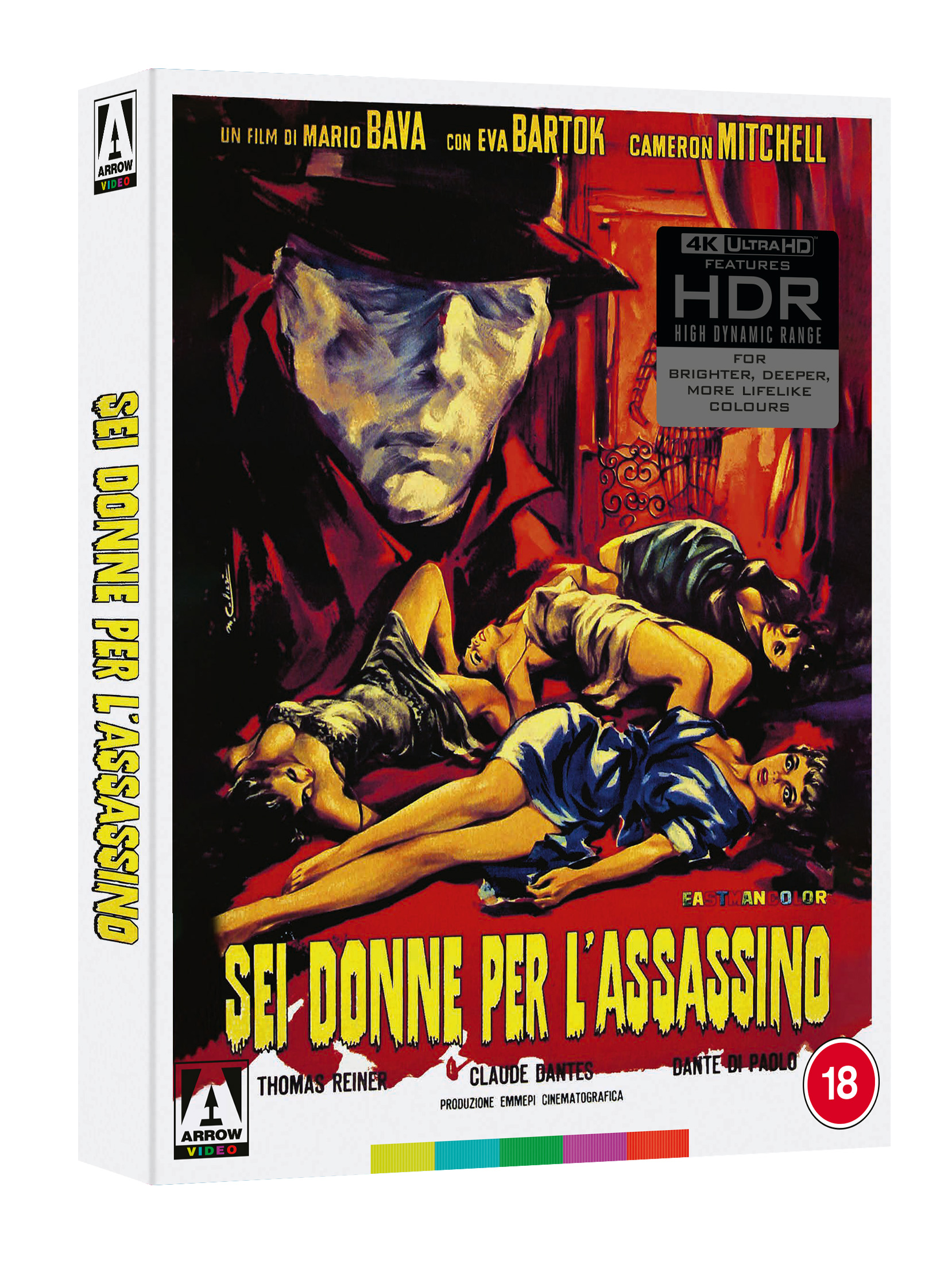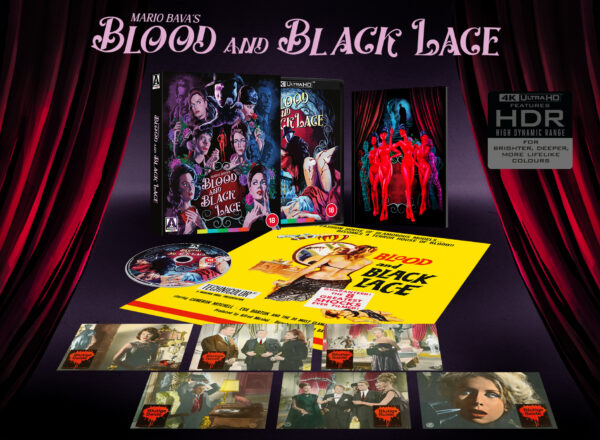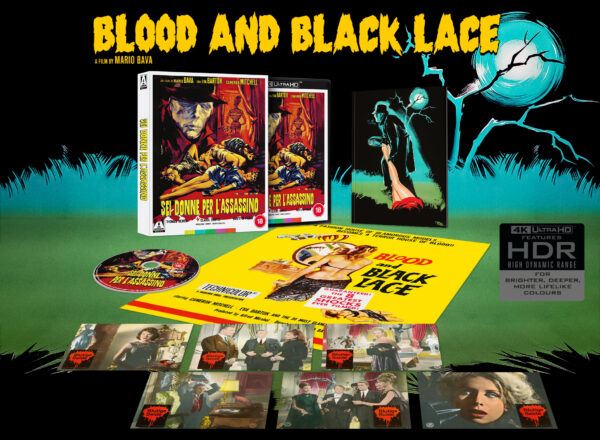
Blood and Black Lace 4K Review

Models are being bumped off at an Italian fashion house by a masked killer in a dark hat, coat with gloves. So far so Giallo. Welcome to Blood and Black Lace, one of the more stunning looking Italian horror murder thrillers of any decade. This one goes back to 1964; made by Giallo master Mario Bava.
Thrown into the mix of suspects are the model’s business owner, their working partner, a drug addict, men of leisure who visit the house and the models themselves. The maguffin for the film is the contents of the diary of the female character killed in the opening of the film. Prying eyes want to possess this diary as it contains damning information about most of the people working at the fashion house, but pursuit of the diary seems to end most people up in the grasp of the masked killer.
The killer outfit is a strong image; almost as if someone took the invisible man motif – A figure with no face, threw on a hat and leather coat and instantly birthed an iconic figure in slasher/killer cinema.
The killings themselves are diverse and brutal. Suffocation of sorts seems to be the preferred modus operandi of the killer; although there is still time for faces being pierced and the odd scalding. One of the most striking images comes mid-act with a model being drowned in a bathtub and their wide-eyed mannequin-esque corpse (mannequins being a concurrent theme across the movie) left to drift under the water as the killer then mutilates their body, letting the cloudy blood seep across the water over the corpse.
Bava likes to shoot faces and show reactions. Once scene where we are meant to follow suspects or potential victims around the room has reactions from key players as they all gaze at a handbag that contains vital information.
The women are made to look beautiful in this film. The sets and lighting casting a stage for them to walk in and out from. French Actress Claud Dantes stands out with her sharp makeup (an attempt to make her look Asian), but her short dark hair and choice of dresses make her stand out against the more traditional big 60s hair the other actresses.
The men in the film on the other hand are all dressed in muted greys and browns. It’s as if Bava isn’t interested in them at all. A line up against a desk scene just goes to show what an ugly bunch of gentlemen they all are. Each eyed by the inspector as a potential sex maniac. Speaking of the police inspector, this character seems more interested in being in charge than he is in solving anything. One character that gets accosted by the officer of the law offers to provide an alibi for their time and the inspector immediately dismisses them instead of asking for the name! Thank god then this character is all but ditched in favour of more interesting developments.
The third act hurries along as the film gives up trying to tantalise any further and changes gear on us. As mentioned; it gives up on the inept police investigator and instead opts to just show the audience what is going on. These revelations make for a compelling alteration in direction of the narrative and also opens up to some strong visuals in the final set pieces.
The film’s lighting is only one part of the style of the film. The mis-en-scene includes set ups involving multiple mannequins placed, disturbingly, around the rooms; often coloured mannequins and even wired dolls, all undressed causing unease in the frame. Mirrors, statues, reflections and the usual noir shadows also play a large part in the films allure. It’s a beautiful looking film and for anyone interested in Giallo, it should always be the first one that people check out if they are new to the genre.
The picture quality is astounding. Arrow’s previous Blu-ray version was already impressive. There are occasional shots that have some blur on them, and panning shots have a lot of motion blur but this is largely down to the film itself as opposed to the restoration. The film has heady use of strong coloured lighting and very dark backgrounds. This is where the image really pops. there are more well lit scenes (the aforementioned scenes with the men) that are slightly harder work, but no kless clear.
Bonus Material
There are three audio tracks. Original Italian and English mono tracks. There is also a commentary by Mario Bava biography, Tim Lucas who needles and threads throughout the film’s narrative with ease.
Psycho Analysis (55 mins) a documentary on Blood and Black Lace and the origins of the giallo genre featuring interviews with directors Dario Argento (Suspiria) and Lamberto Bava (Demons), screenwriter Ernesto Gastaldi (All the Colours of the Dark), critics Roberto Curti and Steve Della Casa, and crime novelists Sandrone Dazieri and Carlo Lucarelli.This analytic documentary of impressive talking heads is the closest we get to a making of, and it is full of incite into what the film is up to.
An appreciation by Hélène Cattet & Bruno Forzani (10 mins) the creative duo behind Amer and The Strange Colour of Your Body’s Tears
Gender and Giallo – (38mins) a visual essay by Michael Mackenzie exploring the giallo’s relationship with the social upheavals of the 1960s and 70s. Mackenzie isn’t new to this work, nor as a provider of essays for Arrow video releases.
Blood and Bava – a panel discussion on Mario Bava featuring Dario Argento, Lamberto Bava and Steve Della Casa, recorded at the 2014 Courmayeur Film Festival.
The Sinister Image: Cameron Mitchell – an episode of David Del Valle’s television series, devoted to the star of Blood and Black Lace and presented in full
– The alternative US opening titles, sourced from Joe Dante’s private print
– Original theatrical trailer
– Image galleries
– Limited edition packaging with reversible sleeve featuring original and newly commissioned artwork by Ilan Sheady
– Limited edition 60-page perfect bound book featuring writing on the film by Howard Hughes, Alan Jones and David Del Valle, plus new writing by Rachael Nisbet and Kat Ellinger
– Fold-out double-sided poster featuring original and newly commissioned artwork by Ilan Sheady
– Six double-sided collector’s postcards
Steven Hurst

